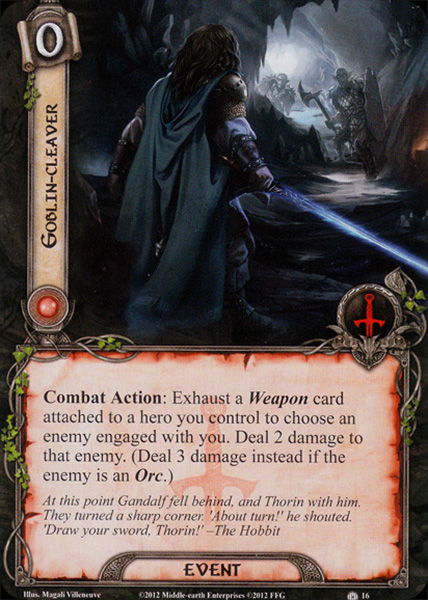The slew of direct damage cards found throughout the game seem to have a general theme. Namely, they aren’t worth the deck space they take up, because the point or two of damage that they deal isn’t enough to offset the cost of forgoing a more permanent option when it comes to killing enemies. In the case of Goblin-cleaver, is it really worth it to take up a card slot or two in order to play a card which probably won’t even kill an enemy completely? Additionally, you have to exhaust a weapon attachment that presumably would be on a hero to kill the target enemy in the first place. Needless to say, this does not appear ideal.
I’m a firm believer that most cards in the game (most; looking at you Core Set!) can work reasonably well if you combine them in the right deck. For the longest time I was having trouble finding the right niche for this alias of Thorin’s legendary sword. However, with the release of the Dream-chaser cycle, I believe that Goblin-cleaver, along with a host of other direct damage cards, has taken on new life. Enter Argalad, who is a master of leaving enemies hanging around with an extra hint point or three, which are perfect targets for Goblin-cleaver. In addition, he’ll be wielding a weapon or two, satisfying the requirement of exhausting a weapon on a hero. Better than this, though, is the fact that Argalad has finally given an avenue to creat a viable direct damage solo deck, since he can both quest and deal damage, something Thalin fails so miserably at. Goblin-cleaver should never be relied on as a primary means of dealing damage. However, in a dedicated direct damage deck, it is one of the many useful tools that can be used to clean up extra hit points that inevitably slip through.
Given this information, let’s take a closer look at the card itself. In a direct damage deck, you want to be able to deal the damage either before staging, or before having to defend. While Goblin-cleaver is restricted to the combat phase, as long you have a weapon attachment on a hero (read: Argalad) at the beginning of the combat phase, you’ll be able to play this card and hopefully knock off an enemy before it attacks you. The fact that it’s free is icing on the cake, when you compare it to other direct damage cards such as Expecting Mischief, Arrows from the Trees, and Forest Patrol. In addition, compared to the restrictions and elements of chance on some of these events, the cost of exhausting a weapon is relatively minuscule. Of course the downside is that it takes up a perhaps valuable card slot, but in a direct damage deck you’ll be wanting to pack plenty of card draw anyway.
Goblin-Cleaver will never be an auto-include card, and it takes a specific type of deck to make it worth it. However, in that deck, it plays its role perfectly, supplying the last push to skewer an enemy. If you’re like me an enjoy finding ways to rejuvenate old cards, try an Argalad deck and see what happens!
